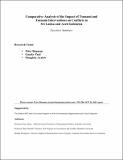Comparative Analysis of the Impact of Tsunami and Tsunami Interventions on Conflicts in Sri Lanka and Aceh/Indonesia
Author(s)
Bauman, Peter; Paul, Gazala; Ayalew, Megistu
Download34_tsunami.pdf (324.5Kb)
Metadata
Show full item recordAbstract
The objective of this field-based research was to assess the impact of natural disasters and disaster interventions on protracted intra-state conflicts and to provide insight for designing and implementing disaster interventions in conflict situations. The field research was conducted in Sri Lanka and Aceh/Indonesia as a comparative analysis. The researchers chose Sri Lanka and Aceh/Indonesia because both were severely hit by the tsunami in December 2004 and have been marred by intra-State conflicts. The distinct nature and intensity of these conflicts provided a platform to observe the implementation of humanitarian assistance and identify the strengths and limitations of the tsunami interventions. The researchers interviewed various experts and officials involved in humanitarian and conflict resolution activities. The researchers also had the opportunity to observe the realities on the ground and to discuss the situation with the tsunami and war affected people.
By applying conflict resolution models and principles in humanitarian assistance this research established, among others, two major findings. First, the tsunami and the tsunami interventions had different impacts on the dynamics of the two conflicts. In Aceh/Indonesia, the major actors, GAM and the Government of Indonesia (GOI), successfully negotiated a Memorandum of Understanding (MOU) ending almost 30 years of war. Conversely, in Sri Lanka the relations between the government and the LTTE deteriorated. The research analyzes these outcomes and attempts to explore the underlying causes of this disparity. Second, in both cases, the tsunami interventions suffered from one major shortcoming. The humanitarian assistance did not reach the thousands of conflict-affected, Internally Displaced Persons (IDPs) who have been living in vulnerable conditions for many years. In addition, drawbacks including: lack of effective coordination, conflict insensitivity, low levels of participation by the beneficiaries, and undermining local capacities were observed by the researchers and identified by interviewees.
The research provided several recommendations including: innovation in fund raising processes and assessment of inflexible and inappropriate mandates, judicious conditionality on debt relief measures so as to encourage the peaceful resolution of conflicts, and cross-learning between the fields of disaster relief, development, and conflict resolution. In addition, it is vital that serious steps are taken in regard to the consideration of unique contexts, local values, and domestic realities. Also, participatory approaches should be implemented at every level of intervention. The researchers suggest that if such and similar steps are taken into account, humanitarian assistance will not exacerbate conflict situations and can help to mitigate war and contribute to resolutions of conflicts between and among diverse groups.
Due to the nature of a summary many of the intricacies and nuances will unfortunately be missing in this document. For a comprehensive discussion please contact Peter Bauman and he will happily forward a copy of the full report.
Date issued
2006-06Publisher
Inter-University Committee on International Migration
Series/Report no.
Rosemarie Rogers Working Paper Series;34